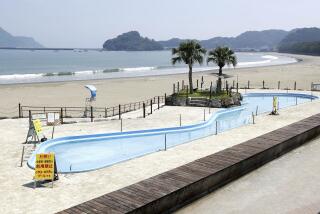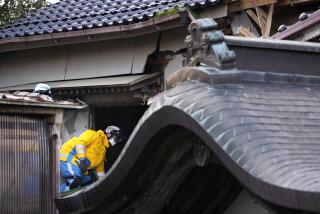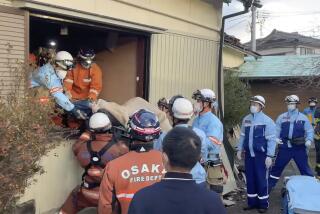Kobe Train Service Opens Link to Outside
- Share via
KOBE, Japan — A direct train run reopened Thursday between the edge of earthquake-devastated Kobe and bustling Osaka, and Tomie Matsumoto used it to bring a few rescued belongings to what will be a new home with relatives.
Wearing gloves and an old overcoat, her head wrapped in a dirty scarf, Matsumoto, 72, slumped with a sigh into a seat. She was carrying a brass pot and two shopping bags, in one of which a teacup was visible.
“If I’m going to live with in-laws, I’ll certainly do my own cooking, and I want to work with my own utensils as much as I can,” she said.
For evacuees such as Matsumoto and for commuters who must travel between Kobe and Osaka, the extension of rail service poked another hole in the wall of isolation that fell over the city when key transportation links and telephone services were shattered by the Jan. 17 quake.
Helicopters continued to fly in emergency food supplies, which were of better quality than before. One relief center was even getting dog and cat food for refugees’ pets.
At a makeshift helicopter pad in a park near City Hall, Self-Defense Forces troops, Kobe city employees and labor union members from Osaka worked together Thursday to unload food from helicopters, putting it on trucks for delivery to evacuation centers.
“At first we could only provide bread and onigiri (rice balls),” said Nobue Kawabata, a Kobe official overseeing the operation. “Now we’re bringing in higher-quality food, the kinds of things people normally eat in a restaurant or at home. . . . The system in general is working more smoothly.”
Hideo Onishi, a local resident volunteering at an evacuation center in a park near the Ogi rail station, said that 200 people were living in tents there provided by the Self-Defense Forces and that as many as 500 people were coming to the center for meals.
Growing numbers of people were returning to work, with the first task for many being to clean up the mess left by the temblor, which was measured by U.S. scientists as a 6.8-magnitude quake.
Hundreds of refugees such as Matsumoto boarded packed trains Thursday, carrying suitcases for the ride to Osaka. Most appeared to be leaving in search of shelter elsewhere, although official estimates of the number of people in local evacuation centers remained unchanged at about 290,000.
Convenience stores were open in many parts of the city, but the variety of supplies was limited, and most homes still had no cooking gas. Only electricity and telephone services have been nearly restored.
The continuing stress of difficult living situations and painful personal and financial losses from the quake was taking a toll on evacuees. Police said Thursday that two evacuees had committed suicide and that there had been several attempts.
Across Kobe, hard-hatted employees were entering buildings due for demolition to retrieve what they could of valuable office equipment.
“We’re bringing out documents, cabinets, office furniture,” said Kazuki Fudeyasu, 50, Kobe branch manager for Asahi Industrial Co., an air-conditioning installation firm. “We’re not sure whether the computers are damaged, but anyway, we’re taking them out.”
Fudeyasu, who was wearing a green worker’s uniform instead of his usual suit and tie, said the firm is looking for a place to rent “but almost nothing is available.”
Despite expanded train service, commuter trips to and from work in Osaka are still horrendous for residents of some parts of Kobe.
“Yesterday my round-trip commute was 9 1/2 hours,” Yuka Okada, 27, an office worker, said while preparing to change buses in downtown Kobe on Thursday evening. “It took me six hours to get home. I think it will be a little better today.”
Health officials, fearful of an influenza epidemic in crowded evacuation centers, announced that 144 new cases of flu were diagnosed Thursday, bringing the total so far to 572.
Meanwhile in Tokyo, there was continued criticism of Prime Minister Tomiichi Murayama for responding too slowly to the crisis--this time from within his own Socialist Party. Legislator Kosuke Uehara said Murayama should have personally taken charge of early rescue operations, which critics charge were delayed by confusion and turf battles among officials.
Times staff writer Teresa Watanabe in Tokyo contributed to this report.
* RELATED STORIES: B1, B3, D1
More to Read
Sign up for Essential California
The most important California stories and recommendations in your inbox every morning.
You may occasionally receive promotional content from the Los Angeles Times.










